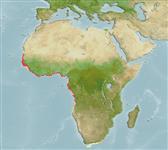Common names from other countries
Environment: milieu / climate zone / depth range / distribution range
Ecologia
; intervalo de profundidade 1 - 55 m (Ref. 435), usually 10 - 30 m (Ref. 435). Tropical; 20°N - 17°S
Eastern Atlantic: from Mauritania to Angola.
Length at first maturity / Tamanho / Peso / Idade
Maturity: Lm ? range ? - ? cm Max length : 9.3 cm CL macho/indeterminado; (Ref. 435)
Maximum carapace width: 19.0 cm (Ref. 435). Also caught by trammel nets (Ref. 417). Occurs at depths from 1 to 55 m, common at depths of 10 to 30 m. Inhabits shallow coastal waters with bottoms consisting of sand or mud (Ref. 435).
Life cycle and mating behavior
Maturidade | Reprodução | Desova | Ovos | Fecundidade | Larvas
Members of the order Decapoda are mostly gonochoric. Mating behavior: Precopulatory courtship ritual is common (through olfactory and tactile cues); usually indirect sperm transfer.
Fischer, W., G. Bianchi and W.B. Scott (eds.). 1981. (Ref. 435)
Status na Lista Vermelha da IUCN (Ref. 130435)
Status no CITES (Ref. 108899)
Not Evaluated
Not Evaluated
Perigo para os humanos
Harmless
Uso pelos humanos
Pescarias: espécies comerciais
| FishSource |
Ferramentas
Fontes da internet
Estimates based on models
Preferred temperature
(Ref.
115969): 22.7 - 28, mean 26.6 (based on 50 cells).
Vulnerabilidade
Low vulnerability (10 of 100).
